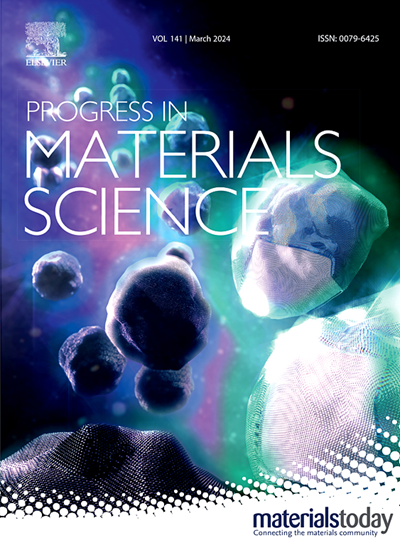桥接电导率和稳定性:克服高能锂离子电池硅阳极退化的有机离子-电子导体的挑战和进展
IF 40
1区 材料科学
Q1 MATERIALS SCIENCE, MULTIDISCIPLINARY
引用次数: 0
摘要
有机混合离子/电子导体(omiec)已成为解决高能锂离子电池(lib)中硅(Si)阳极的关键挑战的变革性材料。尽管Si具有超高的理论容量(4200 mAh g−1),但其实际应用受到严重的体积膨胀(> 300%)、不稳定的固体电解质界面(SEI)和较差的固有电导率的阻碍,导致容量迅速衰减和机械降解。本文系统地探讨了omiec作为多功能粘合剂和保护涂层的双重作用,利用其独特的离子/电子导电性、机械弹性和界面适应性的协同作用。作为粘合剂,omiec建立了强大的3D导电网络,以增强电荷转移动力学,通过动态共价/非共价相互作用适应体积波动,并通过强粘附稳定电极完整性。作为涂层,它们抑制电解质分解,调节均匀的Li+通量以抑制枝晶生长,并形成分层的离子/电子传递途径以最小化极化。本文将omiec分为非均相共混、嵌段共聚物和均相单组分体系,阐明了它们在Si阳极中的结构-性能-性能关系。重点分析了n型OMIECs在还原电位下的掺杂不稳定性和机械脆性,以及复杂表征的空气敏感掺杂态。未来的研究应集中在分子结构设计、聚集态调制、形态设计和电解质相容性优化等方面,通过创新的交联策略来稳定掺杂性能,增强机械弹性。此外,先进的原位表征技术和计算模拟技术的发展对于深入了解omiec在运行过程中的动态行为至关重要。通过将基础材料设计与实际应用见解相结合,本综述强调了omiec在推进下一代锂离子电池方面的变革潜力,为克服Si阳极限制和实现高能量密度、长循环寿命的储能系统提供了路线图。本文章由计算机程序翻译,如有差异,请以英文原文为准。
Bridging conductivity and stability: challenges and progress in organic ionic-electronic conductors for overcoming Si anodes degradation in high-energy lithium-ion batteries
Organic mixed ionic/electronic conductors (OMIECs) have emerged as transformative materials to address the critical challenges of silicon (Si) anodes in high-energy lithium-ion batteries (LIBs). Despite Si’s ultrahigh theoretical capacity (4200 mAh g−1), its practical application is hindered by severe volume expansion (>300 %), unstable solid electrolyte interphase (SEI), and poor intrinsic conductivity, leading to rapid capacity decay and mechanical degradation. This review systematically explores the dual roles of OMIECs as multifunctional binders and protective coatings, leveraging their unique synergy of ionic/electronic conductivity, mechanical elasticity, and interfacial adaptability. As binders, OMIECs establish robust 3D conductive networks to enhance charge transfer kinetics, accommodate volume fluctuations through dynamic covalent/noncovalent interactions, and stabilize electrode integrity via strong adhesion. As coatings, they suppress electrolyte decomposition, regulate homogeneous Li+ flux to inhibit dendrite growth, and form hierarchical ion/electron transport pathways to minimize polarization. The review categorizes OMIECs into heterogeneous blends, block copolymers, and homogeneous single-component systems, elucidating their structure–property-performance relationships in Si anodes. Key challenges are critically analyzed, including the doping instability and mechanical brittleness of n-type OMIECs under reducing potentials, as well as air-sensitive doped states complicating characterization. Future research should focus on a comprehensive approach spanning molecular architecture design, aggregation state modulation, morphology design and electrolyte compatibility optimization to stabilize doping performance and enhance mechanical resilience through innovative crosslinking strategies. Additionally, the development of advanced in situ characterization techniques and computational simulation techniques will be crucial for gaining deeper insights into the dynamic behavior of OMIECs during operation. By bridging fundamental material design with practical application insights, this review highlights the transformative potential of OMIECs in advancing next-generation LIBs, offering a roadmap for overcoming Si anode limitations and achieving high-energy–density, long-cycle-life energy storage systems.
求助全文
通过发布文献求助,成功后即可免费获取论文全文。
去求助
来源期刊

Progress in Materials Science
工程技术-材料科学:综合
CiteScore
59.60
自引率
0.80%
发文量
101
审稿时长
11.4 months
期刊介绍:
Progress in Materials Science is a journal that publishes authoritative and critical reviews of recent advances in the science of materials. The focus of the journal is on the fundamental aspects of materials science, particularly those concerning microstructure and nanostructure and their relationship to properties. Emphasis is also placed on the thermodynamics, kinetics, mechanisms, and modeling of processes within materials, as well as the understanding of material properties in engineering and other applications.
The journal welcomes reviews from authors who are active leaders in the field of materials science and have a strong scientific track record. Materials of interest include metallic, ceramic, polymeric, biological, medical, and composite materials in all forms.
Manuscripts submitted to Progress in Materials Science are generally longer than those found in other research journals. While the focus is on invited reviews, interested authors may submit a proposal for consideration. Non-invited manuscripts are required to be preceded by the submission of a proposal. Authors publishing in Progress in Materials Science have the option to publish their research via subscription or open access. Open access publication requires the author or research funder to meet a publication fee (APC).
Abstracting and indexing services for Progress in Materials Science include Current Contents, Science Citation Index Expanded, Materials Science Citation Index, Chemical Abstracts, Engineering Index, INSPEC, and Scopus.
 求助内容:
求助内容: 应助结果提醒方式:
应助结果提醒方式:


